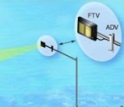|

Press Release 05-069
Acoustic 3-D Imaging Unveils Swimming Behavior of Microscopic Ocean Plankton

Nearly invisible creatures captured on "Fish TV"
May 5, 2005
Below the ocean's surface, currents sweep microscopic animals called zooplankton into patches or clusters. The survival of predatory ocean animals like fish and whales--as well as the success of human fishers--can depend on finding those clusters of zooplankton and the larger animals that feed on them. Scientists long have suspected that the clusters form when zooplankton swim against ocean currents, but researchers have never had a way to track the motions of these miniscule sea creatures.
Now, using a newly developed, 3-D imaging system called "Fish TV," an international team of scientists has analyzed the behavior of more than 375,000 individual zooplankton swimming against currents. In the May 6 issue of the journal Science, researchers from Israel, the United States and Germany showed that zooplankton keep their position at various depths by "treadmilling" against currents.
The new Fish TV system, developed by scientist Jules Jaffe of the Scripps Institution of Oceanography in La Jolla, Calif., allowed the team to track individual zooplankton at two coastal sites in the Red Sea. Along with Jaffe and Peter Franks from Scripps, the team included Amatzia Genin and Ruth Reef from the Hebrew University, and Claudio Richter from the Center for Tropical Marine Ecology in Bremen, Germany.
Scuba divers attached Fish TV's sonar transducer to a large underwater tripod extending 20 feet above the sea floor. The transducer was connected by a cable to a control unit with a computer and other electronic hardware.
"Technological advances in studying the movements of very small animals in the ocean have allowed us to discover that these organisms aren't simply at the mercy of physical forces like currents," said Philip Taylor, director of the National Science Foundation's (NSF) biological oceanography program, which funded the research. "These animals are altering their position in the environment in unique ways."
"One of the most amazing aspects of this research is that we were able to see 375,000 individual zooplankton, many as small as 1 millimeter in length, as they were swimming," said Jaffe. "It's remarkable that we can capture images of such tiny creatures, in three dimensions from two meters [6.5 feet] away."
That small zooplankton are capable of remaining at a constant depth with a precision of centimeters, sometimes in the face of strong vertical currents, is incredible, said Genin. "It implies that these organisms have extremely sensitive depth sensors."
The research was also funded by the German Ministry for Education and Research through the Red Sea Program and the U.S.-Israel Binational Science Foundation, and by the Office of Naval Research and California Sea Grant.
-NSF-

Media Contacts
Cheryl L. Dybas, NSF (703) 292-7734 cdybas@nsf.gov
Mario Aguilera, Scripps Institution of Oceanography (858) 534-3624 maguilera@ucsd.edu

The National Science Foundation (NSF) is an independent federal agency that
supports fundamental research and education across all fields of science and
engineering, with an annual budget of $6.06 billion. NSF funds reach all 50
states through grants to over 1,900 universities and institutions. Each year,
NSF receives about 45,000 competitive requests for funding, and makes over
11,500 new funding awards. NSF also awards over $400 million in
professional and service contracts yearly.
 Get News Updates by Email Get News Updates by Email
Useful NSF Web Sites:
NSF Home Page: http://www.nsf.gov
NSF News: http://www.nsf.gov/news/
For the News Media: http://www.nsf.gov/news/newsroom.jsp
Science and Engineering Statistics: http://www.nsf.gov/statistics/
Awards Searches: http://www.nsf.gov/awardsearch/
| 


